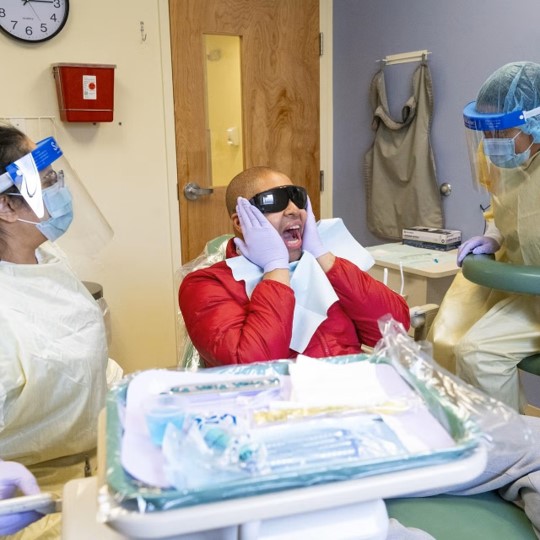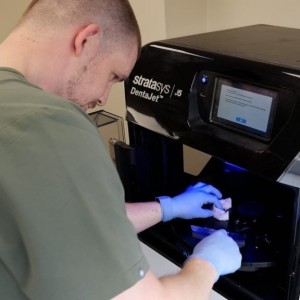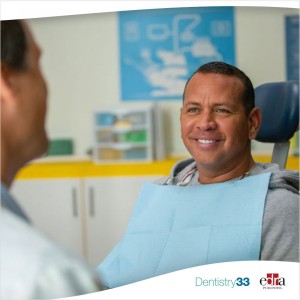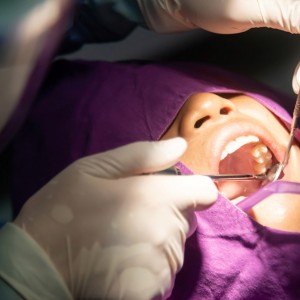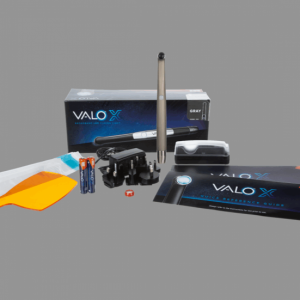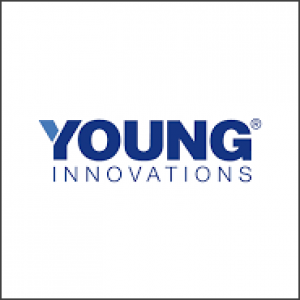
These Dental Patients Were Left Behind. These Clinics Changed That
Athanasios Zavras, DG93, calls this experience one of the most profound moments of his dental career. He was meeting a new patient at one of the several clinics Tufts University School of Dental Medicine runs for people with intellectual and developmental disabilities. This patient had tetraplegia and was non-verbal and largely immobilized by her condition.
Her parents explained that although many people assumed their daughter could not understand interactions, she was communicative in her own way. “So I started talking to her,” says Zavras, the Delta Dental of Massachusetts Professor in Public Health and Community Service. “And suddenly I saw a smile. It was one of the most memorable moments of my career, because I realized we could communicate.”
Moments like that have repeated themselves over the past half century at these clinics, formerly known as Tufts Dental Facilities, or TDF, and recently renamed Tufts Special Care Dental Clinics, or TSCDC. This network was a pioneering effort to address the urgent oral health needs of a population that has been documented to shoulder an increased burden of oral disease, yet has far less access to care.
TSCDC is a unique partnership between Tufts dental school, the Commonwealth of Massachusetts, and the patients, families, and caregivers, Zavras says. It currently provides care for approximately 7,000 patients through seven clinics across the state. At each clinic, care teams of dentists, hygienists, social workers, and other specialists work together to provide personalized care, close to home. The program was established in 1976, following a lawsuit brought by Massachusetts families seeking equitable dental care for their loved ones.
Communication Is Key
While no two TSCDC patients are alike, all care begins with communication, says Darren Drag, D00, DG01, DG02, director of TSCDC and assistant professor of Public Health and Community Service. “We start with in-depth discussions with parents or caregivers, so that we can individualize the approach for each person.” The same principle applies to adult patients who can communicate for themselves.
“For some of our patients, listening to the drill, or looking into a bright light can trigger negative responses, so we modify,” says Drag. “Sometimes we’ll do dentistry standing up rather than sitting down, or we may not use a certain instrument.” Simple adaptations, like lowering noise levels or staggering appointments to make the clinic less crowded, can help patients feel at ease. Telehealth or home visits can also support a positive treatment experience, and successful follow-up care.
Sometimes optimal treatment doesn’t happen in a traditional clinic at all. Zavras describes a TSCDC patient with autism who had not seen a dentist for 12 years. A care team comprised of a hygienist, social worker, and behavioral therapist visited the patient at home and, by working closely with their parents, was able to do a full screening. “At one point, the parent said, ‘OK, it’s time for a break,’ and the patient took 15 minutes by themselves in their room. When they came back, the hygienist was able to continue the exam. Experiences like this show us that we need to listen to parents at every minute of the process,” he says.
Looking to the Future
Program leaders are focused on building for the future, and sharing the collaborative school/state model with other dental schools. TSCDC currently serves about 12% of the 56,000 individuals registered with the state Department of Developmental Services, a sign there are unmet needs for patient care and professional training.
“The care we provide is really state of the science,” says Drag, “but clinical science and technology evolve continuously.” Areas for future investment at TSCDC include modernizing some facilities, updating clinical tools and technology, and expanding training opportunities for TUSDM students and dental professionals. There are even plans to use artificial intelligence and data modeling to improve triage, scheduling, and other operational aspects of TSCDC. This past July, TUSDM launched a new residency in public health dentistry; post-graduate students in this program will work and learn at TSCDC sites.
Individual Needs
Jessica Jordan, D25, recently completed her degree at Tufts and is looking forward to a career in pediatric dentistry. Her training included a rotation at TSCDC in Wrentham, Massachusetts, an experience she says will help her serve patients of all abilities. “Every patient is unique, and for patients with disabilities or specific medical conditions, we need to be extra mindful of individual needs,” she says.
“For example, on my rotation we saw a patient that had a higher risk of aspiration, so we couldn’t use water for that patient,” she says. “Some patients have a lot of dental anxiety, and we can often help by simply checking in a lot, explaining what’s going on.” Jordan hopes that more dental students and professionals can gain experience in treating patients with disabilities. “This is such an underserved population,” she says, “and it’s really valuable to have these kinds of specialized clinics.”
Informed Decisions
Kris McGourthy and her young-adult children, Michael and Amber, have been part of the TSCDC community for many years. Matt and Amber live with a degenerative neurological disorder that has led to some complex dental care needs. Through many treatments, McGourthy says, TSCDC has helped their family make informed decisions, through thorough, respectful communication. “My kids are adults who make their own decisions now, and the clinic is great about treating them as equals,” she says.
In her professional life, McGourthy works with developmentally disabled adults, and notes that it’s often hard for disabled individuals to find good dental care as they get older. The patient care and professional training offered at TSCDC can make a meaningful difference, she says. “They’re used to working with people of all different abilities and they’re so positive. It’s the perfect fit.”
Author: Kris Willcox
Source: https://now.tufts.edu/
 Related articles
Related articles
News 14 August 2025
With renewed energy and commitment, Dentsply Sirona once again brought people together for a charity walk that ties into its commitment to increasing access to oral healthcare globally.
Thousands of patients across the UK are having their dental experience transformed thanks to the power of additive manufacturing.
Editorials 30 May 2024
This profile is one in an ongoing series highlighting School of Dentistry alumni, donors and students.
News 13 June 2023
OraPharma, Alex Rodriguez raise awareness about importance of managing gum disease
The Cover Your Bases campaign includes educational content about the disease and encourages patients to talk to their dentist about comprehensive treatment options. The campaign launch is timed to...
Dr. Chris Phelps held a dental marketing workshop at the start of the International Academy of Ceramic Implantology’s annual congress in Atlanta, which took place April 13 to 15.
 Read more
Read more
Oral surgery 27 October 2025
The authors assessed the incidence of postoperative bleeding in patients who were highly anticoagulated and in patients who underwent extensive oral surgical procedures and who continued using oral...
Ultradent Products, Inc., a leading developer and manufacturer of high-tech dental materials, is announcing the launch of VALO X Colors: new, vibrant finishes for the award-winning VALO X curing...
News 27 October 2025
OrthoFX, a leading innovator of shorter wear time aligner systems, announces AirFlex with new PrecisionFinish Aligners.
News 27 October 2025
Young Innovations Strengthens North American Leadership Team
Young Innovations, a leading global manufacturer and distributor of dental supplies and equipment, is pleased to announce two significant additions to its North American leadership team as part of...
Oral pathology 24 October 2025
Isolation and characterization of dental pulp stem cells from a supernumerary tooth
Dental pulp stem cells (DPSCs) were primarily derived from the pulp tissues of primary incisors and permanent third molar teeth, whereas no report to our knowledge has yet been documented on deriving...


